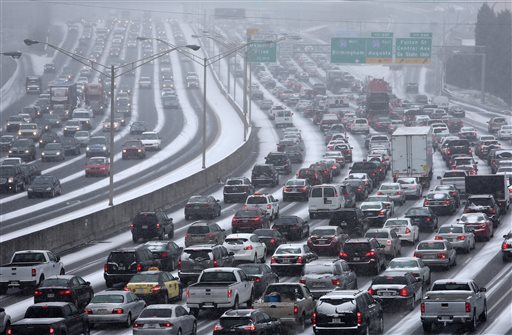Escape from Atlanta: Stranded on I-285 for 13 hours, Jim Catanzaro took action
Thursday, January 30, 2014
For 13 hours, Chattanooga State President Jim Catanzaro sat through headline-grabbing nothingness - no help, no hope, and no movement.
But finally, around 10:30 a.m. Wednesday, he saw a woman walking past his rental car. Catanzaro had seen this same woman earlier that morning, marching through 2 inches of snow in 10-degree weather, abandoning this particular section of the parking lot formerly known as Interstate 285.
Now, the woman was back. Catanzaro asked if she had seen any sign of hope.
She said she talked with a Georgia State Highway Patrol trooper. She asked when they could leave the interstate. The trooper told her an evacuation plan would take effect -- in 24 hours.
Catanzaro had expected to get back to Chattanooga around 11 p.m. Tuesday. Now, he was cold, and tired, and miserable. He decided to break the rules.
"I had no alternative," he said. "Nobody could move in front of me. Nobody could move behind me. The sides? I was pinned in. I had no recourse. Either stay there for 24 hours, or do something bold."
From the right lane of the highway, Catanzaro steered the car into a 6-foot-deep ditch, accelerated up a slight hill and reversed his car while yanking the steering wheel left. Once he stopped, he was somewhere in the 10 feet that separates a forest and the road, facing the opposite direction of traffic.
Slowly -- no faster than 5 mph -- he steered on snow, grass and patches of ice. For about 1 1/2 miles, he weaved around signs, light poles, vehicles. Cars, abandoned by drivers and spit out at awkward angles onto the highway's shoulder, formed an obstacle course.
Finally, after squeezing between a pair of empty school buses, Catanzaro reached the ramp leading to I-285. To get out, back to regular roads with regular stop-and-go rhythms, he would have to drive up the ramp, going the wrong direction. He took the chance, and exited unscathed.
"Enough is enough," he told himself. "I don't care what the rules are here. I don't care what the probabilities are. I'm going to go for it and see what happens."
Catanzaro was one of thousands desperate to escape Atlanta's historic traffic nightmare. Authorities did not have an official figure for how many people remained stuck on the city's highways Wednesday evening, more than a day after Winter Storm Leon took city and state officials by surprise.
But even without statistics, images showing miles of brake lights helped explain how much disruption the storm had caused. And many anecdotes -- like Catanzaro's -- have put faces on the two-day (and counting) Atlanta apocalypse.
This week, the city is a place where stranded children sleep in schools, stranded adults sleep in stores, and at least one stranded woman gives birth to a stranded baby on the highway. And there, on the choked highways, drivers who weren't in labor abandoned their cars, choosing to walk miles through the cold instead of waiting any longer.
On Wednesday, the Georgia State Patrol reported 1,200 vehicular accidents, 130 injuries and one weather-related fatality on state roads. Gov. Nathan Deal blamed meteorologists, saying nobody was prepared for the snow and ice, and Atlanta Mayor Kasim Reed blamed businesses and schools for all leaving at the same time Tuesday.
For his part, Catanzaro blames most of the city and state leaders. As a community college president, he said he knows leadership is key. They should have been ready, and they should have quickly formed a plan to clear the highway.
He wasn't even supposed to drive through Atlanta. He was supposed to fly. Catanzaro and Robert Denn, Chattanooga State's dean of school relations, were in Orlando, Fla., for a community college conference, but their flight home was canceled Tuesday afternoon.
Catanzaro said he didn't want to miss a meeting scheduled for Wednesday morning, so he and Denn rented a car and started to drive. For the first seven hours of the trip, the roads were open.
"It looked great," he said, "until we came around the corner."
Almost as soon as he exited onto Interstate 285, the traffic halted. It never started again. At first, Catanzaro was patient. He assumed someone in charge would revive the paralyzed highway.
He read magazines about the economy and books about Barbados on his iPad. At night, he tried to sleep. But hazard lights shined in his eyes, and nearby semi trucks growled.
Finally, he drove against the grain, and got on a regular street. Then, he took back roads that pointed north, eventually exiting onto Interstate 75 in a section that was past the Atlanta congestion.
One lane sat open, and cars moved north at 25 mph. Slowly, Catanzaro and Denn crept back toward Chattanooga, and around 2:30 p.m. they made it home. They had been in the car for about 25 hours.
"What an ordeal," Catanzaro said. "What. An. Ordeal."
Contact Staff Writer Tyler Jett at 423-757-6476 or at tjett@timesfreepress.com.


